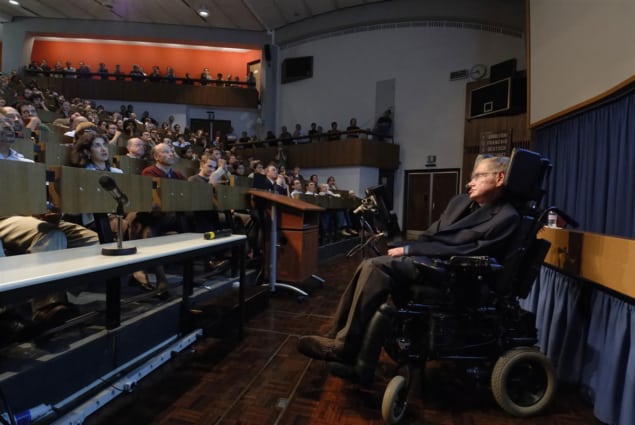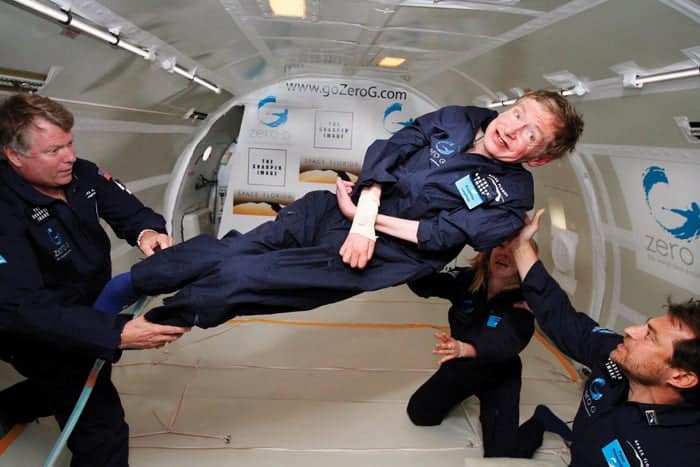Laura Hiscott reviews Hawking Hawking: the Selling of a Scientific Celebrity by Charles Seife
 With a title like Hawking Hawking: the Selling of a Scientific Celebrity, science writer Charles Seife must have known his new book was going to cause a stir. Indeed, for reasons unknown to Seife himself, his biography of the late cosmologist Stephen Hawking has so far not been able to find a UK publisher. I don’t know why either, but it wouldn’t surprise me if none of them wanted to be part of an attack on a beloved national icon. And the book does claim to be an attack – with publicity material and a video trailer asking whether Hawking’s true talent was not physics, but self-promotion. So I opened this book with more than a little curiosity about the contrast between who Hawking was and who the public believed him to be.
With a title like Hawking Hawking: the Selling of a Scientific Celebrity, science writer Charles Seife must have known his new book was going to cause a stir. Indeed, for reasons unknown to Seife himself, his biography of the late cosmologist Stephen Hawking has so far not been able to find a UK publisher. I don’t know why either, but it wouldn’t surprise me if none of them wanted to be part of an attack on a beloved national icon. And the book does claim to be an attack – with publicity material and a video trailer asking whether Hawking’s true talent was not physics, but self-promotion. So I opened this book with more than a little curiosity about the contrast between who Hawking was and who the public believed him to be.
Hawking Hawking begins with a chapter entitled “Next to Newton”, which describes both the position Hawking occupies in the public psyche and his physical burial place in Westminster Abbey in London, where his ashes were interred following his death in March 2018 at the age of 76. From here, it tells Hawking’s story going backwards in time, in search of the person behind the persona, “as the accumulated layers of celebrity and legend are stripped away”.
It is true that a lot of myths built up about Hawking over the years, many of which he happily indulged. Seife describes how Hawking, unlike most academics, actively courted the media, especially towards the end of his life. Anecdotes I particularly enjoyed include his jokey mathematical derivation of the optimal conditions for the England football team’s success in the 2014 World Cup, which he presented for the gambling chain Paddy Power, and his appearances on popular TV shows such as The Simpsons.
In some of these media stunts, including the latter, Hawking was portrayed as being in the league of (or even cleverer than) Einstein. But, as Seife notes, most physicists would not rate him quite that highly, his brilliance and contributions notwithstanding. Hawking himself dismissed such comparisons, saying they were “media hype”, but, given his enthusiastic participation in stunts that encouraged these associations, I had to wonder how authentic Hawking’s attempts at modesty really were.
Despite the book’s claim to be an exposé of how Hawking crafted his public image, the accounts of these and other publicity stunts are mostly relegated to the early chapters. The rest of Hawking Hawking recounts stories about his personal and academic life, which was mostly spent at the University of Cambridge. To describe “Hawking the human”, Seife draws on many sources, including the warts-and-all memoirs of his first wife Jane, interviews with people who knew him, and other books written about him such as Hawking Incorporated: Stephen Hawking and the Anthropology of the Knowing Subject by philosopher and anthropologist Hélène Mialet.
These personal stories are interspersed with long scientific passages explaining Hawking’s work on the nature of black holes and his attempts to unify the theories of general relativity and quantum mechanics. Seife also describes much of the related research done by Hawking’s contemporaries. After all, to discuss whether Hawking’s science was as significant as people believe, Seife has to explain that science and put it in context. It proved impossible, however, to disentangle the many aspects of Hawking’s life and personality, with the result that the scientific sections often lead into stories (sometimes less than flattering) about what Hawking might have been like to work with – or against.
The one I found most shocking detailed how, in 1999, Hawking repeatedly tried to have a PhD student called Andrew Farley kicked off the course at Cambridge, apparently because Farley’s research threatened Hawking’s belief that information is destroyed in black holes (which Hawking later changed his mind about). The university ignored Hawking, and Farley completed his PhD, but Farley’s confidence was badly knocked. Having previously admired Hawking since childhood, Farley said that the common advice to “never meet your heroes” was particularly apt. The incident also resulted in Hawking ending his long friendship with Farley’s supervisor Peter D’Eath, who had been Hawking’s own graduate student many years earlier, and never spoke to him again.
While this story doesn’t demonstrate Hawking “hawking” himself to the media, it does make me wonder about the interplay between his fame and his character. Was it, in other words, because of his notoriety that he felt entitled to act beyond his power in this way? The book offers some speculation on this possibility, noting that it was shortly after Hawking became famous with A Brief History of Time in 1988 that his marriage to his first wife Jane started falling apart. But even if Hawking’s fame did feed some of his less-endearing characteristics, it becomes clear as the book goes backwards in time that they were there from the beginning. For example, his public contempt for other subjects such as philosophy and theology were foreshadowed by his disdain and lack of support for Jane Hawking’s bona fide research in the field of medieval studies.
It’s worth underlining, though, that the book also includes stories that paint Hawking in a better light. He often gave large sums of money (including his fee for the Paddy Power stunt) to charity, despite not always having a lot to spare, due to the expense of his round-the-clock medical care. He also asked to have meetings set up with local children with disabilities whenever he was travelling. Contrary to the notion that he cared more about self-promotion than anything else, these meetings were never publicized. Seife addresses Hawking’s own disability openly and considers how it affected all aspects of his life. One heart-rending story quotes Hawking as saying that, when his children were young, he “missed not being able to play with them physically”.
Despite his condition, Hawking never appeared to feel sorry for himself, according to several acquaintances quoted by Seife. However, in an added complexity, his admirable traits and his character flaws may sometimes have been two sides of the same coin. His stoicism was certainly remarkable, but perhaps it went hand in hand with a stubborn refusal to give “an admission of defeat”. This made him delay getting external help, even when, in 1976, his wife Jane and their then nine-year-old son Robert were overburdened with caring for him.
If Hawking himself were to read this book, perhaps he would bristle most at the suggestion that his disability played a part in his becoming a scientist superstar – “the likes of which hadn’t been seen since Einstein”. It’s clear that he wanted to be known for his science – despite his disability, not because of it. But if he wasn’t the world’s greatest physicist (or its best communicator) in reality, then why did he achieve this level of fame?
It appears that Hawking was given to attention-drawing antics even before he was famous
It appears that Hawking was given to attention-drawing antics even before he was famous. In one dramatic story from his time as a PhD student under the supervision of Dennis Sciama at Cambridge, Hawking attended a lecture given by the eminent astrophysicist Fred Hoyle at the Royal Society. Hoyle had been presenting his new work for the first time but once the seminar was over, Hawking stood up and pointed out a flaw in Hoyle’s thinking in front of 100 other scientists. It was a memorable performance that gave the impression that he had done the calculations in his head on the spot. Unbeknown to the audience, however, Hawking had seen an early draft of the paper, which his officemate had been working on. Interestingly, when Hawking started his PhD, he had actually wanted Hoyle to be his supervisor, but Hoyle had rejected him. So was this stunt driven by some resentment he harboured? Or would he have done it anyway?
Hawking certainly wasn’t the first physicist to employ such tactics. Another celebrity physicist with dramatic tendencies was Richard Feynman, with whom Hawking has some intriguing parallels. According to one acquaintance cited in this book, Feynman was described as “always concerned with generating anecdotes about himself”. The two physicists got to know each other when Hawking spent a year-long fellowship in 1974–1975 at Caltech, where Feynman was based. Some of their interactions during that time are detailed in a chapter titled “Black swan”.
Both Hawking and Feynman received attention for their unashamed enjoyment of strip clubs and from their friendships with billionaires (who had often made their money from morally questionable and environmentally damaging activities). Today, these attitudes have aged poorly: the consequences of damaging the environment are becoming painfully clear, and it is now better understood that physics should not be made to seem like a boys’ club where women are unwelcome. In their own time, however, both physicists seemed to enjoy the notoriety these associations brought them.
Perhaps Hawking achieved a greater level of fame because the media expectations of celebrity were changing, and he arrived on the scene at the right time (he was 20 years Feynman’s junior). Or perhaps it was because his publishers used the human story around his disability to market his books. It is likely not possible to give a definitive answer, but Seife’s exploration results in a deeply insightful biography of a flawed human being who lived an extraordinary life.

In search of the real Stephen Hawking
As for Seife’s decision to structure the book in reverse chronological order, I am not convinced. It’s a clever idea, especially given that Hawking’s research played with reversing the arrow of time, but it doesn’t lend itself well to describing the science. Early chapters describe Hawking’s later-career research, but it can only be understood by giving some background of what came before. You’re often therefore faced with a second explanation in a later chapter, when you reach the point where that research actually happened. So in order to avoid repetition, the first description is often short, but with a comment in brackets promising more in a later chapter. It’s all rather disorientating.
The structure does, however, lend itself to the human story, and I found the final chapters (about Hawking’s early life) markedly poignant, knowing already all that was to follow in his life. I was left with the feeling that Hawking Hawking is not really an exposé; it is less explosive and more sympathetic to its subject than the publisher’s description led me to expect. Is it too cynical of me to wonder if this was a publicity stunt of their own?
- 2021 Basic Books 400pp $30hb
